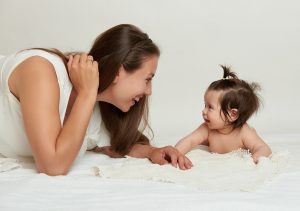 Like it or not, our childhood has a lot to do with how we parent. In fact, attachment research has shown that our attachment style with our own parents is the biggest predictor of the attachment style we’ll have with our child. Attachment style refers to the internal “working models” we develop of how relationships function. They influence the way we relate to important people in our lives. The attachments we form in our early relationships with caretakers can have a serious impact on our feelings of insecurity, anxiety, fear, avoidance, and satisfaction in our closest relationships throughout our lives.
Like it or not, our childhood has a lot to do with how we parent. In fact, attachment research has shown that our attachment style with our own parents is the biggest predictor of the attachment style we’ll have with our child. Attachment style refers to the internal “working models” we develop of how relationships function. They influence the way we relate to important people in our lives. The attachments we form in our early relationships with caretakers can have a serious impact on our feelings of insecurity, anxiety, fear, avoidance, and satisfaction in our closest relationships throughout our lives.
Experiencing an insecure attachment pattern as a child can hurt us in many ways. However, it does not mean we are doomed to repeat the past. The good news is that attachment research has also found that it isn’t what happened to us as children but how much we’ve felt the full pain of our childhoods and made sense of what happened to us that predicts what kind of parent we will be. No matter how bad things may have been, if we are willing to explore and face even the painful realities of our childhood and create a coherent narrative of our story, then we can become a different kind of parent and have a healthier more secure attachment with our children.
In aiming to better understand our past, it’s helpful to explore what attachment style we may have had with our parents or other influential caretakers. Keep in mind we can have different attachment styles with the different figures in our lives. As you become familiar with your attachment style, you may have insight into many of your relationships, past and present.
 Secure Attachment – Dr. Daniel Siegel co-author of Parenting from the Inside Out often refers to the four S’s of attachment in which a child feels safe, soothed, seen and secure. This creates what is called a secure attachment. Children with a secure attachment can see their caretaker as a secure base from which to venture out and explore the world. They feel they can move freely, but that they can always come back to the parent to feel safe.
Secure Attachment – Dr. Daniel Siegel co-author of Parenting from the Inside Out often refers to the four S’s of attachment in which a child feels safe, soothed, seen and secure. This creates what is called a secure attachment. Children with a secure attachment can see their caretaker as a secure base from which to venture out and explore the world. They feel they can move freely, but that they can always come back to the parent to feel safe.
The “working model” of relationships that a securely attached child forms is that you can trust others to be there for you when you need them. Children who form a secure attachment grow up better able to maintain their unique sense of identity, while still being able to connect with others. They can feel secure in themselves, while engaging in healthy modes of relating. You can learn more about how different attachment styles affect ways people relate as adults in my blog “How Your Attachment Style Impacts Your Relationship.”
 Anxious/Preoccupied Attachment – Children may experience an anxious or preoccupied attachment style when they have a parent who is sometimes there for them but sometimes isn’t. These parents tend to be intermittently available or rewarding, then inexplicably unavailable and misattuned, leaving the child confused and frustrated. Parents who form this style of attachment may regularly (though unintentionally) look to their kids to meet their needs instead of vice versa. They express an “emotional hunger” that drains the child and acts as an unfulfilling substitute for real love and nurturance. As a result, the child may feel clingy, desperate, or anxious around the parent who isn’t meeting his or her emotional needs.
Anxious/Preoccupied Attachment – Children may experience an anxious or preoccupied attachment style when they have a parent who is sometimes there for them but sometimes isn’t. These parents tend to be intermittently available or rewarding, then inexplicably unavailable and misattuned, leaving the child confused and frustrated. Parents who form this style of attachment may regularly (though unintentionally) look to their kids to meet their needs instead of vice versa. They express an “emotional hunger” that drains the child and acts as an unfulfilling substitute for real love and nurturance. As a result, the child may feel clingy, desperate, or anxious around the parent who isn’t meeting his or her emotional needs.
The “working model” a child with this type of attachment forms is that you have to always be vigilant and attentive in relationships to get your needs met. When children grow up with an anxious attachment style they have difficulty trusting that others will be there for them when they need them. They may also continue to feel clingy or insecure in their adult relationships. This is why, as parents, it’s essential that we not use our children to make us feel better or loved. For the sake of our children, it is essential that we get our adult needs met by other adults. it’s important to evaluate how often we turn to our children to make us feel good within ourselves. We also need to pay attention to how much of the time we are distracted and inconsistent in how we relate or respond to our kids.
 Avoidant/ Dismissive Attachment – In an avoidant/ dismissive attachment, the parent may meet the child’s basic needs, but he or she will have trouble responding to the child on an emotional level. For the child, the parent may feel like an “emotional desert.” Children in this situation learn that the best way to get their needs met by their parent is to act like they don’t have any. They adapt by becoming removed from their own emotions and developing a pseudo-independent t stance, (i.e. I can take care of myself).
Avoidant/ Dismissive Attachment – In an avoidant/ dismissive attachment, the parent may meet the child’s basic needs, but he or she will have trouble responding to the child on an emotional level. For the child, the parent may feel like an “emotional desert.” Children in this situation learn that the best way to get their needs met by their parent is to act like they don’t have any. They adapt by becoming removed from their own emotions and developing a pseudo-independent t stance, (i.e. I can take care of myself).
The “working model” of relationships for a child with this type of attachment is that you should avoid expressing your needs and wants and should keep an emotional distance from others to be safe. This early lack of emotional closeness can make it hard for children to be in touch with their own desires or take a chance on getting close to others once they’ve grown up. In adulthood, they may struggle with intimacy and have a hard time being vulnerable or showing any dependence on others. They often ward off partners’ attempts to be close, experiencing them as “needy.” They may also have difficulty remembering much from their childhood, and they may see early experience as having no impact on who they are as an adult.
Our children need us to be emotionally available and connected to them. Just meeting a child’s basic needs is not enough. It is important to explore ways we might be inward or distant from our own emotions. We can ask ourselves, are we making time and giving importance to having an emotionally close relationship with our children?
 Disorganized Attachment – A disorganized attachment can form when a parent is frightening to their child or when they are frightened by the child. In this scenario, the parent reacts unpredictably. For example, the parent may at one moment laugh and reward a certain behavior and, at another, explode with anger at the same behavior. Because of this erratic and unpredictable way of acting, children have no organized strategy to get their needs met. They experience fear without solution. They want to go to their parent for safety, but the closer they get, the more fear they feel. Kids need consistency to feel safe and secure. Instead, what they are getting is a parent who is actually terrifying at times. These children often display emotional turmoil and a confusing mix of behaviors, because they lack a basic feeling of safety.
Disorganized Attachment – A disorganized attachment can form when a parent is frightening to their child or when they are frightened by the child. In this scenario, the parent reacts unpredictably. For example, the parent may at one moment laugh and reward a certain behavior and, at another, explode with anger at the same behavior. Because of this erratic and unpredictable way of acting, children have no organized strategy to get their needs met. They experience fear without solution. They want to go to their parent for safety, but the closer they get, the more fear they feel. Kids need consistency to feel safe and secure. Instead, what they are getting is a parent who is actually terrifying at times. These children often display emotional turmoil and a confusing mix of behaviors, because they lack a basic feeling of safety.
The “working model” of attachment a child with this type of parent forms is that others are dangerous and will hurt you, but that you desperately need them.. This style of attachment can cause people to feel both avoidant and anxious in their adult relationships. They may feel desperate or clingy when someone pulls away, then aloof and withdrawn when someone comes toward them. Their behavior in relationships is often erratic and even scary for their partner.
Understanding the impact of our early experiences and how we adapted allows us to better understand ourselves as people and as parents. The influence of our early attachments on how we learned to relate should not be underestimated; it can offer us valuable insight into how we may behave as a parent. Yet, in all cases, no matter what our attachment style was, being a good parent starts with exploring our own story and being willing to look at the inevitable pain we experienced in growing up.
We can develop ourselves and develop healthier “working models” of relationships, which will allow our children to have a healthy secure attachment with us. But in order to make that happen, we have to be open and focus on ourselves. This self-reflective approach to parenting is one I illustrate at length in an online course I teach called “Compassionate Parenting.” In the course, I devote an entire week to attachment style, because it is such an influential and fundamental concept to understand when having children of our own.
As we look into our attachment history and the implications it may have for how we relate as adults, it’s important to practice self-compassion. To change our attachment style will mean working on making sense of the most painful parts of our childhood. This process can bring up a lot of emotion, and it’s vital to be on our own side and not turn on ourselves. Remember that reaching a level of self-understanding is an essential part of growing and developing. At any point in life, we can start to change our attachment style by being willing to look at what hurt us, creating a coherent narrative of our story and by seeking therapy.
To learn more about how to develop an earned secure attachment, join Dr. Lisa Firestone and Dr. Daniel Siegel for the online course “Making Sense of Your Life: Understanding Your Past to Liberate Your Present and Empower Your Future.”

